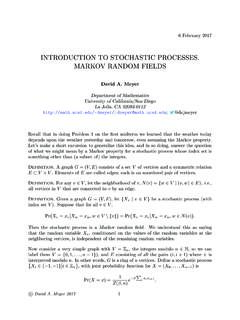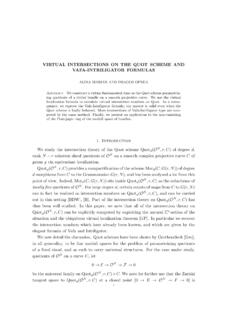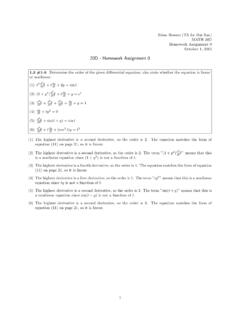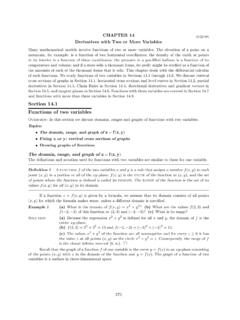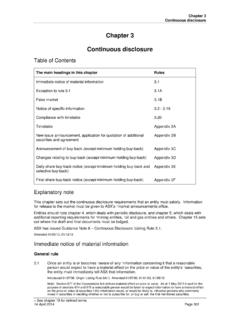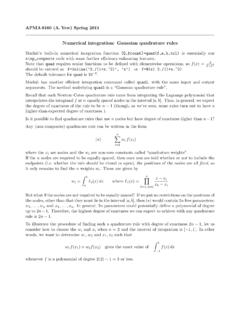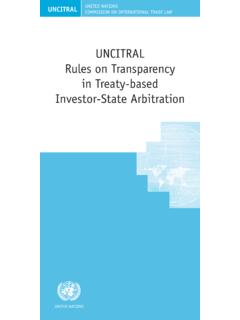Transcription of Section 14.4 Chain Rules with two variables
1 (3/23/08) Section Rules with two variablesOverview:In this Section we discuss procedures for differentiating composite functions with two vari-ables. Then we consider second-order and higher-order derivatives of such : Using the Chain Rule for one variable The general Chain Rule with two variables Higher order partial derivativesUsing the Chain Rule for one variablePartial derivatives of composite functions of the formsz=F(g(x, y)) can be found directly with theChain Rule for one variable, as is illustrated in the following three 1 Find thex-andy-derivatives ofz= (x2y3+ sinx) find thex-derivative, we consideryto be constant and apply the one-variable ChainRule formuladdx(f10) = 10f9dfdxfrom Section We obtain x[(x2y3+ sinx)10] = 10(x2y3+ sinx)9 x(x2y3+ sinx)= 10(x2y3+ sinx)9(2xy3+ cosx).
2 Similarly, we find they-derivative by treatingxas a constant and using the sameone-variable Chain Rule formula withyas variable: y[(x2y3+ sinx)10] = 10(x2y3+ sinx)9 y(x2y3+ sinx)= 10(x2y3+ sinx)9(3x2y2). Example 2 The radius (meters) of a spherical balloon is given as a functionr=r(P, T) of theatmospheric pressureP(atmospheres) and the temperatureT(degrees Celsius). Atone moment the radius is ten meters, the rate of change of the radius with respect toatmospheric pressure is meters per atmosphere, and the rate of change of theradius with respect to the temperature is meter per degree. What are the rates ofchange of the volumeV=43 r3of the balloon with respect toPandTat that time?
3 SolutionWe first take theP-derivative withTconstant and then take theT-derivative withPconstant, using the Chain Rule for one variable in each case to differentiater3. Weobtain V P= P(43 r3)=13 r2 r P V P= T(43 r3)=13 r2 r 10, r/ P= , and r/ T= then gives V P=13 (102)( ) = 13 .= metersatmosphere V T=13 (102)( ) =115 .= metersdegree. 317p. 318 (3/23/08) Section , Chain Rules with two variablesExample 3 What are thex- andy-derivatives ofz=F(g(x, y)) atx= 5, y= 6 ifg(5,6) = 10, F (10) = 7, gx(5,6) = 3, andgy(5,6) = 11?SolutionBy the Chain Rule formuladdt[F(u(t))] =F (u(t))u (t) for one variable with firstxand thenyin place oft, we obtain[ x{F(g(x, y))}]x=5,y=6=F (g(5,6))gx(5,6)=F (10)gx(5,6) = ( 7)(3) = 21[ y{F(g(x, y))}]x=5,y=6=F (g(5,6))gy(5,6)=F (10)gy(5,6) = ( 7)(11) = 77.
4 Partial derivatives of composite functions of the formsF(t) =f(x(t), y(t)) andF(s, t)=f(x(s, t), y(s, t)) can be found directly with the Chain Rule for one variable if the outside functionz=f(x, y) is given in terms of power functions, exponential functions, logarithms, trigonometricfunctions, and inverse trigonometric functions rather than just by a letter name. This is illustratedin the following 4 Find thet-derivative ofz=f(x(t), y(t)), wheref(x, y) =x5y6, x(t) =et, andy(t) = (x, y) is a product of powers ofxandy, the composite functionf(x(t), y(t))can be rewritten as a function oft. We obtainf(x(t), y(t)) = [x(t)]5[y(t)]6= (et)5(t1/2)6= the Product and Chain Rules for one variable giveddt[f(x(t), y(t))] =ddt(e5tt3) =e5tddt(t3) +t3ddt(e5t)= 3t2e5t+t3e5tddt(5t) = 3t2e5t+ 5t3e5t.
5 The general Chain Rule with two variablesWe the following general Chain Rule is needed to find derivatives of composite functions in the formz=f(x(t), y(t)) orz=f(x(s, t), y(s, t)) in cases where the outer functionfhas only a letter name. Webegin with functions of the first 1 (The Chain Rule)Thet-derivative of the composite functionz=f(x(t), y(t))isddt[f(x(t), y(t))] =fx(x(t), y(t))x (t) +fy(x(t), y(t))y (t).(1)We assume in this theorem and its applications thatx=x(t) andy=y(t) have first derivativesattand thatz=f(x, y) has continuous first-order derivatives in an open circle centered at (x(t), y(t)).Learn equation(1)as the following statement: thet-derivative of the composite function equalsthex-derivative of the outer functionz=f(x, y) at the point (x(t), y(t)) multiplied by thet-derivativeof the inner functionx=x(t), plus they-derivative of the outer function at (x(t), y(t)) multipled by thet-derivative of the inner functiony=y(t).
6 Section , Chain Rules with two variablesp. 319 (3/23/08)Proof of Theorem 1:We fixtand set (x, y) = (x(t), y(t)). We consider nonzero tso small that(x(t+ t), y(t+ t)) is in the circle wherefhas continuous first derivatives and set x=x(t+ t) x(t)and y=y(t+ t) y(t). Then, by the definition of the derivative,ddt[f(x(t), y(t))] = lim t 0f(x(t+ t), y(t+ t)) f(x(t), y(t)) t= lim t 0f(x+ x, y+ y) f(x, y) t.(2)We express the changef(x+ x, y+ y) f(x, y) in the value ofz=f(x, y) from (x, y) to(x+ x, y+ y) as the change in thex-direction from (x, y) to (x+ x, y) plus the change in they-direction from (x+ x, y) to (x+ x, y+ y), as indicated in Figure 1:f(x+ x, y+ y) f(x, y) = [f(x+ x, y) f(x, y)] + [f(x+ x, y+ y) f(x+ x, y)].
7 (3)(Notice that the termsf(x+ x, y) and f(x+ x, y) on the right side of(3)cancel to give the leftside.)(x, y)(x+ x, y)(x+ x, y+ y)(x, y)(c1, y)(x+ x, y)(x+ x, c2)(x+ x, y+ y)FIGURE 1 FIGURE 2We can apply the Mean Value Theorem from Section to the expression in the first set of squarebrackets on the right of(3)whereyis constant and to the expression in the second set of square bracketswherexis constant. We conclude that there is a numberc1betweenxandx+ xand a numberc2betweenyandy+ y(see Figure 2) such thatf(x+ x, y) f(x, y) =fx(c1, y) xf(x+ x, y+ y) f(x+ x, y) =fy(x+ x, c2) y.(4)We combine equations(3)and(4)and divide by tto obtainf(x+ x, y+ y) f(x, y) t=fx(c1, y0)[ x t]+fy(x+ x, c2)[ y t].
8 (5)The functionsx=x(t) andx=y(t) are continuous attbecause they have derivatives at thatpoint. Consequently, as t 0, the numbers xand yboth tend to zero and the triangle in Figure 2collapses to the point (x, y). Because the partial derivatives offare continuous, the termfx(c1, y+ y)in(5)tends tofx(x, y) and the termfy(x, c2) tends tofy(x, y) as t 0. Moreover x/ t x (t) and y/ t y (t) as t 0, so equation(5)with(2)givesddt[f(x(t), y(t))] =fx(x(t), y(t))x (t) +fy(x(t), y(t))y (t)to establish the 320 (3/23/08) Section , Chain Rules with two variablesExample 5 What is thet-derivative ofz=f(x(t), y(t)) att= 1 ifx(1) = 2, y(1) = 3,x (1) = 4,y (1) = 5,fx(2,3) = 6, andfy(2,3) = 7?
9 SolutionBy formula(1)witht= 1,[ddt{f(x(t), y(t))}]t=1=fx(x(1), y(1))x (1) +fy(x(1), y(1))y (1)=fx(2,3)x (1) +fy(2,3)y (1)= ( 6)( 4) + (7)(5) = 59. Example 6 FindG (2) whereG(t) =h(t2, t3) andh=h(x, y) is such thathx(4,8) = 10 andhy(4,8) = (1)givesG (t) =ddt[h(t2, t3)] =hx(t2, t3)ddt(t2) +hy(t2, t3)ddt(t3)= 2thx(t2, t3) + 3t2hy(t2, t3).Therefore,G (2) = 2(2)hx(22,23) + 3(22)hy(22,23)= 4hx(4,8) + 12hy(4,8) = 4(10) + 12( 20) = 200. In applications it often helps to interpret the Chain Rule formula(1)in terms of rates of write it in the formdFdt= F xdxdt+ F ydydt(6)without reference to where the derivatives are evaluated. Equation(6)states that the rate of change ofFwith respect totequals the rate of change ofFwith respect toxmultiplied by the rate of change ofxwith respect tot, plus the rate of change ofFwith respect toymultiplied by the rate of change ofywith respect 7A small plane uses gasoline at the rate ofr=r(h, v) gallons per hour when it is flyingat an elevation ofhfeet above the ground and its air speed isvknots (nautical miles perhour).
10 At a moment when the plane has an altitude of 8000 feet and a speed of 120 knots,its height is increasing 500 feet per minute and it is accelerating 3 knots per what rate is its gasoline consumption increasing or decreasing at that moment if ath= 8000 andv= 120 the functionrand its derivatives have the valuesr= gallonsper hour, r/ h= 2 10 4gallons per hour per foot, and r/ v= gallons perhour per knot?(1)(1)Data adapted fromCessna 172N Information Manual, Wichita Kansas: Cessna Aircraft Company, 1978, , Chain Rules with two variablesp. 321 (3/23/08)SolutionAt the moment in question the plane s rate of gas consumptionris changing at theratedrdt=[ r hgallons per hourfoot][dhdtfeetminute]+[ r vgallons per hourknot][dvdtknotsminute]=[ 2 10 4gallons per hourfoot][500 feet per minute]+[ per hourknot][3knotsminute]= ( 2 10 4)(500) + ( )(3)gallons per hourminute= per hourminute.

